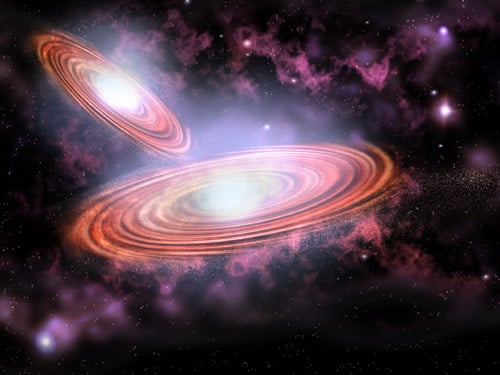This article is more than 1 year old
Stargazers spy elusive binary black hole system
Two monsters circling in distant quasar
Astronomers at the National Optical Astronomy Observatory (NOAO) believe they've spotted a binary black hole system - two monsters orbiting each other at the centre of a quasar* 5bn light-years from Earth.
NOAO explains that galaxies commonly form with a black hole at their heart, and if they're part of a cluster of galaxies, collisions are likely. What's not certain is what then happens to the two black holes, although NOAO notes that theoretically "they will orbit each other and eventually merge into an even larger black hole".
Such phenomena have hitherto proved elusive, until NOAO astronomers Todd Boroson and Tod Lauer scoured the Sloan Digital Sky Survey, which encompasses 17,500 quasars, for the "characteristic dual black hole signature".
NOAO elaborates: "The signature of a black hole in a galaxy has been known for many years. The material falling into a black hole emits light in narrow wavelength regions forming emission lines that can be seen when the light is dispersed into a spectrum.
"These emission lines carry the information about the speed and direction of the black hole and the material falling into it. If two black holes are present, they would orbit each other before merging and would have a characteristic dual signature in their emission lines. This signature has now been found."
The quasar in question is J1536+0441, lying in the direction of the constellation Serpens Caput, which shows "two sets of broad hydrogen spectral lines", as New Scientist puts it. To make sure they weren't seeing two galaxies "superimposed on each other", Boroson and Lauer "determined that the quasars were at the same red-shift determined distance and that there was a signature of only one host galaxy".
Boroson said: “The double set of broad emission lines is pretty conclusive evidence of two black holes. If in fact this were a chance superposition, one of the objects must be quite peculiar."
The two black holes "appear to be separated by only 1/10 of a parsec - a tenth of the distance from Earth to the nearest star", and have an orbital period of almost 100 years. They weigh in at 107.3 and 108.9 solar masses or, as NOAO puts it: "The smaller black hole has a mass 20 million times that of the sun; the larger one is 50 times bigger, as determined by the their orbital velocities."
Boroson and Lauer's work appears in this week's Nature. The abstract can be found here. ®
Bootnote
*NOAO nicely explains: "Quasars are the most luminous versions of the general class of objects known as active galaxies, which can be a hundred times brighter than our Milky Way galaxy, and powered by the accretion of material into supermassive black holes in their nuclei. The matter falling into the black hole doesn’t go directly in, but orbits around the black hole forming a flat accretion disc, much like the soap scum on water orbiting around an open drain."

